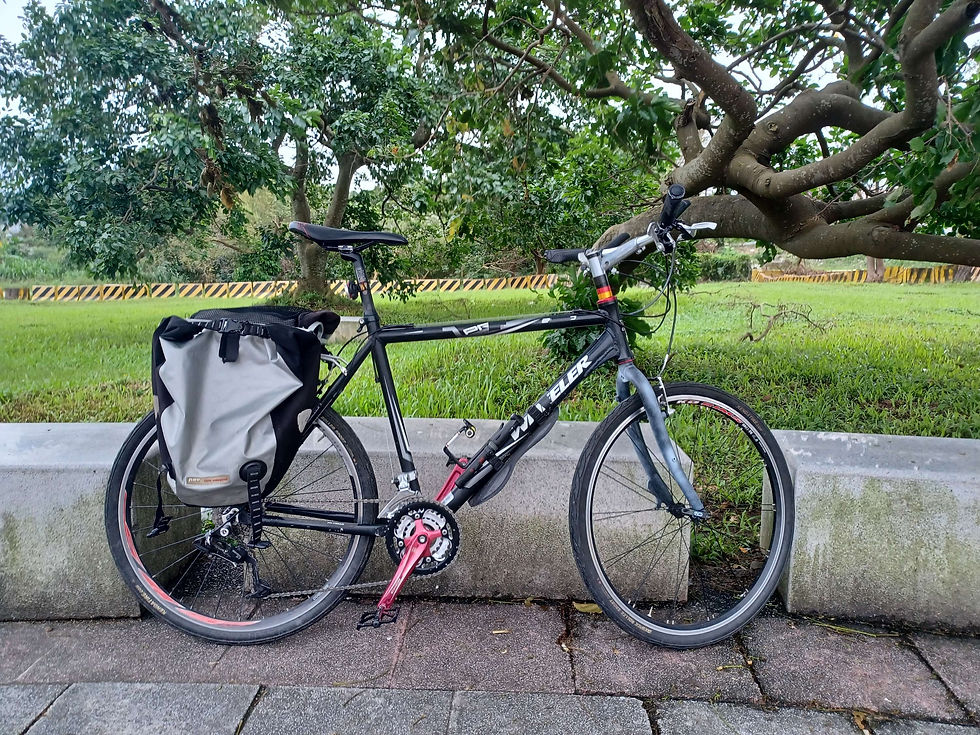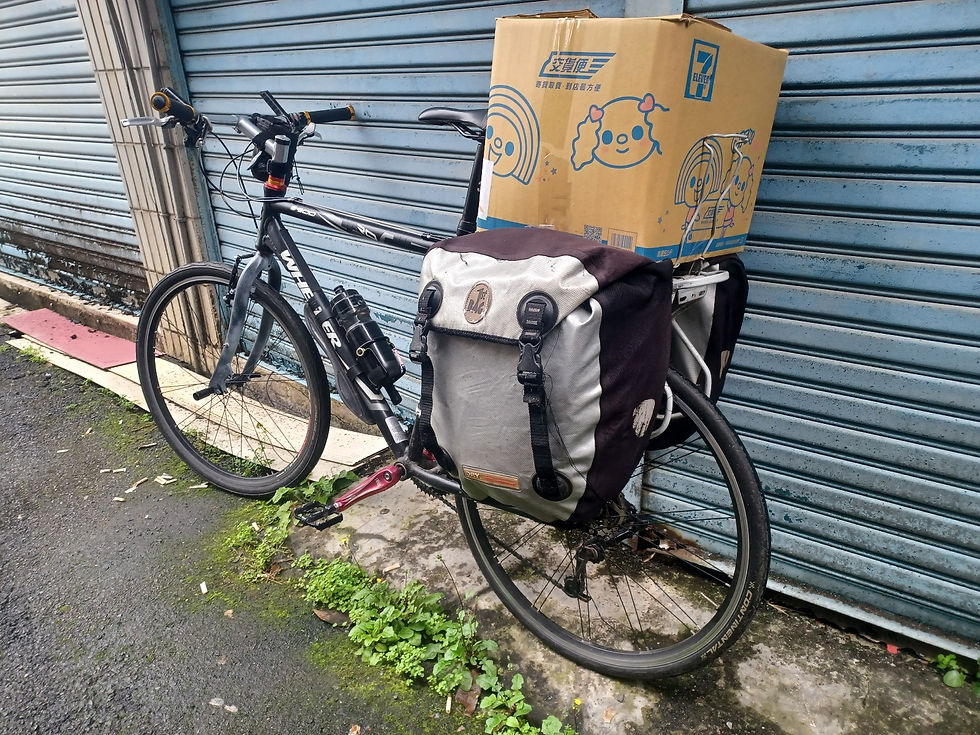My Wheeler mountain winter bike (2)
- Gerhard Wanninger
- Dec 2, 2024
- 5 min read
Updated: Aug 25
Braking
Lever: Tektro
I used my vintage Taiwanese MTB Tektro 4-finger brake levers made from aluminum. Many might not realize that in the 1990s, there were also lighter 2-finger levers available. However, these are too narrow and not very comfortable for road cycling or long tours. Like all older alloy components, the paint on these parts tends to peel. While some might find this unattractive, I view it as character.
V-Brakes: Tektro 855AL
Although my friend at the bike parts store recommended switching to disc brakes, I decided to stick with V-Brakes as a DIY mechanic. They are affordable, simple to install, and provide precise and dependable braking when properly adjusted.
I upgraded the brake pads to high-quality used red/black Kool Stops, which I would recommend for improved braking performance and to safeguard the alloy rims - because of their softer yet stickier rubber material.

Many people online suggest that I switch to disc brakes. However, since I'm not a racer and wish to avoid the chemicals associated with hydraulic discs, I prefer mechanical brakes, specifically V-brakes. They are easy to install, and maintaining or replacing the cables and brake pads is straightforward. In traffic, I keep my fingers gently on the levers in case I need to stop suddenly. V-brakes offer reliable and ample stopping power, giving me peace of mind.
Wheelset
As previously stated, I utilized my 'old' MTB wheelset; the rim, spokes, and hubs were all in good condition, approximately 80% new.
Rim:
Front: KD Rims, crafted from 6061-T6 alloy in Taiwan, with 28 straight round spokes and Bitex hubs that include sealed bearings, also made in Taiwan.
Rear: Mountain Sport rims, made of alloy, featuring 28 aero spokes and Shimano Deore hubs.
Tire & Tube:
Front & rear tire: Kenda Kwick Roller Sport folding, 26' x 1.5 (40-559), tubes: Kenda 1.5/1.75 F/V.
After experiencing the performance of the original Kenda tires, I replaced the rear tire with a 'made in Germany' Continental Grand Prix 26' folding 1 1/8 (28-559) road tire.
With the Continentals, The bike's responsiveness and acceleration improved dramatically, elevating the entire bike to a whole new level. I would like to replace the front tire with the same Continentals, but I sold the second one before this build.
Comments on the wheelset and the tires
The wheelset is robust and performing admirably, so I'm not overly worried about the aero spokes on the rear. A friend suggested the Kenda tires due to their high quality, but they feel slow and heavy during rides. While these Kendas provide a smoother experience over road surfaces compared to my narrower 25mm road tires, they lack traction on wet roads, as I slipped on a rubber surface at a very low speed.
Later, I used my other rear wheelset, which already had the Continental Grand Prix tires, 26*1 1/8 (28-559) I mounted some time ago. These tires provide a noticeably different experience compared to the Kenda's. Featuring the same material, construction, and design as Continental's larger 700c models, they deliver the same high-quality feel as my road bike and roll much faster than their Taiwan-made counterparts.
In my experience, high-quality 26' wheels and tire sizes are becoming increasingly scarce, not just in Taiwan. With the rise in popularity of 700c tires for road and gravel bikes and the shift in standard mountain bike tires from 26' to 27.5' and even 29', the original 26' size is losing its appeal and is becoming an outlier in the industry. Finding lightweight rim brake wheelsets is becoming more challenging, and there is limited development in 26' road tires. You can find quality 700c road tires weighing around 200g each, while the smaller 26' tires weigh about 500g each.
On this particular frame I could get up to 700c or 29' wheels, but not every MTB frame has the space required for changing to larger wheels.
Assembling
Since I already had most of the parts and some experience assembling bikes from components, the whole process went smoothly. I had the essential tools, like those for the bottom bracket, and everyone has hex or Allen keys in various sizes at home—a sharp cable cutter is essential!
As I mentioned, I had to purchase
-a front derailleur
-a new set of rear V-brakes for safety reasons
and I opted for a new square tapered crankset with a traditional 113.5 sealed bottom bracket.
Before beginning the assembly, I envisioned the bike I wanted to build to suit my needs. Choosing the parts was gratifying, and assembling it piece by piece was incredibly rewarding as I watched it transform into a finished product.
I'm particularly proud of sourcing the 'old' 25.4 handlebar/stem combination in silver, which contrasts with the common black found here in Taiwan. I personally restored the fork from a damaged original by smoothing out the scratches and applying a smooth base coat, making it a unique piece.
Costs
Since some components came from the original build and my parts bin, it's challenging to assign a price to the entire bike. I purchased some new parts for functionality and safety, specifically:
- crankset including bottom bracket: USD 24.00
- front derailleur: USD 15.00
- cantilever brakes (front and rear): USD 10.00
I spent about USD 49.00 on new parts, excluding shipping, with the remainder being an inventive form of recycling. Compared to a mid-range road bike, this build was quite cost-effective. Although I won't assign a price to the value of my hands, body, and soul, the joy from building it certainly contributed to extending my life expectancy.
Riding Experiences
The bike is crafted to endure challenging conditions with remarkable stability, making it a genuine mountain bike. This stability is crucial when carrying loads of up to 25 kg on the rack and in both clip-on bags, whether for shopping or recycling paper. The wider tires help to smooth out Taiwan's poor-quality roads, which often have bumps and occasional cracks. While riding on these surfaces, I learn to relax and brake gently.
This 'working bike' comes with flat, wide pedals that are suitable for everyday shoes, although I prefer using clipless pedals with cleated shoes. I have the flexibility to ride in any shoes I choose and walk comfortably after cycling. The upright seating position allows me to see further and better anticipate oncoming traffic. Overall, it's a very nice bike that I thoroughly enjoy.
Some thoughts...
In Taiwan, I have access to Eurosport, which airs a variety of cycling sports such as road cycling, cyclocross, and mountain biking, among others. While many cyclists attempt to replicate these sports during their personal rides, it's not advisable to do so on public roads. Most people lack sponsors, a mechanic to handle issues during rides, or someone to provide food and drinks along the way.
Although I own both a road racing bike and an endurance road bike, this Wheeler mountain winter bike has rekindled the initial joy that drew me to cycling. I don't require special cycling attire (except for the shorts), I can wear any shoes with my flat pedals, and my saddle bags offer ample space for carrying items not only on cycling tours but also for shopping, recycling, and more.
This bike allows me to ride without the pressure to perform, whether I'm riding solo or with others. Its upright position lets me enjoy the surroundings, appreciate the view, and be aware of any potential hazards. I can stop to take a photo whenever something captures my attention. I leave this bike unlocked outside convenience stores or coffee shops, relishing time with family and friends.
Isn't this the true joy of cycling?


Dream on, Gerhard
-The end of the story but the beginning of new chapters-




Comments